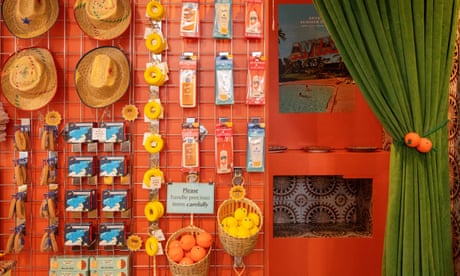
The summer holidays may be some time away, but for those who can’t wait the souvenirs are already on sale. Coral bracelets, kitsch keyrings and shell necklaces are some of this season’s most covetable accessories.
Anya Hindmarch has brought the holiday mood to west London with a pop-up shop that she describes as “a love letter to the classic souvenir shops you find tucked away in favourite holiday destinations”.
The store’s facade is covered in vintage tiling and a retro awning while inside there is everything from fridge magnets to rolls of Kodak Gold film interspersed among Hindmarch’s classic raffia tote bags, and up-cycled shirts by the London brand Pikol using Spanish souvenir glass cloths.
Meanwhile, the accessories sections of fast fashion retailers such as Zara are peppered with riffs on ceramic shell necklaces and coral-effect bracelets. Balenciaga’s latest it-bag “The Rodeo” comes adorned with a cacophony of charms, including a tasselled doorkey fob – evoking that sudden realisation that you forgot to return it on checkout – alongside garish dolphin- and heart-shaped key rings - similar to those bought from a beachside stand to placate a child.
Of course, one person’s tat has always been another’s treasure. As the author Lucy Lethbridge notes, souvenirs are rooted in ideas around taste. “I mean, 50 years ago it may be that tourists took home kitsch things because they thought they were beautiful,” she says. “Nowadays, the young know that kitsch is kitsch, but it’s very knowing, it’s a sort of camp aesthetic which is popular.”
While Balenciaga’s souvenir-inspired look costs £8,500, on TikTok users have got to work emulating it on the cheap. Scouting out beaten up bags from vintage sites, there are detailed tutorials on how to “Jane Birkin-ify” them, a reference to the actor who was known for covering the Hermès Birkin bag she inspired with cheap trinkets and Free Tibet stickers. Pop stars, including Dua Lipa and Lily Allen, have joined the trend of adorning bags with tchotchkes. On the secondhand platform Depop, searches for bag charms this month are up 29%.
Henrik Lischke, Grazia’s senior fashion features editor, says part of the trend’s appeal is that it adds a unique element to the wearer’s look. Lischke, who describes himself as “a souvenir superfan”, likes to wear chunky beaded necklaces he picked up for €10 on the Greek island of Hydra, and a feathered brooch he found in the gift shop of the Fife Arms, in Scotland. “I love pieces that are specific to the area you find them in. They help add personality to a simple outfit. I’d much rather go to a souvenir shop than a luxury shopping mall.”
i-D’s global editorial director, Olivia Singer, has made an all-black wardrobe featuring sharp silhouettes from Marc Jacobs and Alaïa her signature, but it’s a pair of cheap Eiffel Tower shaped earrings bought from a merch stand in Paris that she wears the most. Other favourites include a shell necklace from a beach holiday and a silver pyramid charm necklace from a trip to Egypt. “It’s a fine line between wearing souvenirs and dressing like Edina Monsoon, but it’s nice to wear nice memories of things,” says Singer.
Pikol’s founder, Dan Branston, says he sourced the glass cloths from car boots, explaining that nostalgia is a key part of the trend. He favours a faded cloth. “It has more of a back story. It makes you think about the person that brought it back in their suitcase from a holiday.”
Lischke believes the trend is a wider backlash to the quiet luxury mood that has dominated fashion discourse. “Souvenirs aren’t minimalist, but they do have forever appeal. People want to wear things that evoke joy. We are heading towards a loud fashion moment. Souvenirs are the first wave.”